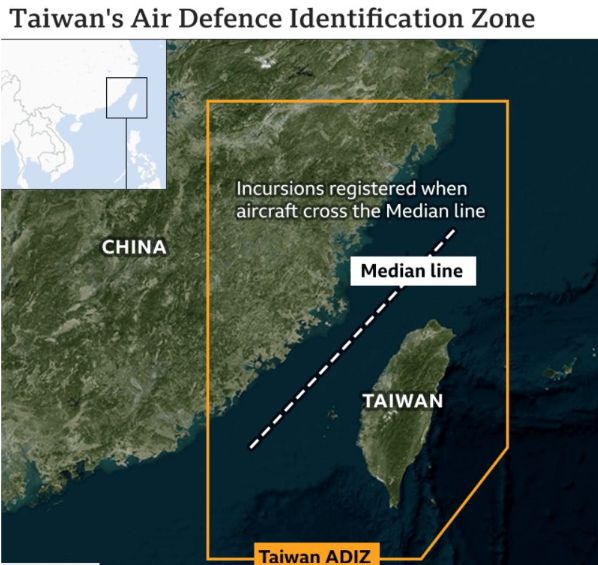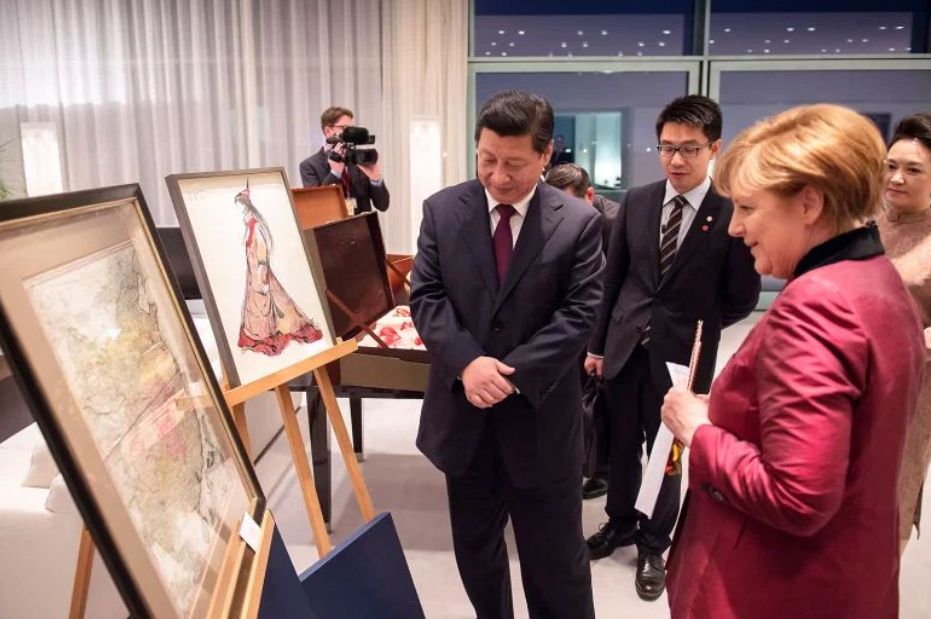By Eric Vandenbroeck and co-workers
Today China
violated Taiwanese airspace with 30 warplanes as Putin emboldens Xi. So far
in 2022, Taiwan has reported 465 incursions, a nearly 50% increase from the
same period last year. The sheer number of sorties has put the Taiwanese air
force under immense pressure, and it has suffered a string of fatal accidents
in recent years.

President Biden said the US’s responsibility to protect the self-ruled
island was “even stronger” and said any attempt by China to use force against
Taiwan would “not be appropriate … it would dislocate the entire region. And
while many perceived this as a gaffe, there is an old saying in politics
that a gaffe is when a politician says what they mean. Biden might be who is cognisant
of the 1979 mutual defense treaty called the Taiwan
Relations Act, which asserted that the United States would
“consider any effort to determine the future of Taiwan by other than peaceful
means, including by boycotts or embargoes, a threat to the peace and security
of the Western Pacific area and of grave concern to the United States.” It also
stated that the United States would maintain the capacity to come to Taiwan’s
defense and make the arms necessary for its security on the island.
The context was as striking as Biden’s words. He spoke at a press
conference in Tokyo after meetings with Japan’s new prime minister, Fumio
Kishida, and a few days earlier with South Korea’s new president, Yoon Suk-yeol. The US president and Kishida had also hunkered
down in a Quad Summit with PM Narendra Modi of India and Australia’s new prime
minister, Anthony Albanese.
Until the past few years, Chinese threats
to conquer the recalcitrant province could be shrugged off; China lacked
the means. Nor, it was argued, would the regime in Beijing put the fruits of
its ‘economic miracle’ at risk. Now, however, that threat is palpable and
credible. The Xi Jinping regime has swallowed Hong Kong, extended its de facto
dominion across the South China Sea, condemned the Uighurs to Sinification, and
bragged that by 2027 it will have the “intelligentized” military assets needed to bring
Taiwan to heel 2027. It has been pumping renminbi into military
modernization, and its navy, coast guard, and air force now dominate the space within the
‘first island ring.’
A pro-Taiwan defense posture is popular with the once famously pacifist
Japanese public: an April 2021 Nikkei poll found 74 percent of
respondents supporting active Japanese engagement toward ‘stability in the Taiwan
Strait.’ That feeling is reciprocated in Taiwan, where 58 percent of
respondents to another poll said they believe Japanese forces would
come to Taiwan’s aid against a Chinese invasion.
The Southeast Asian states
have been hesitant to engage, though what happens to Taiwan inevitably will
have substantial knock-on impacts on Southeast Asia and strategically important
SCS shipping lanes. President Biden’s reply to a seemingly random question
is thus also a wake-up call to Singapore, Manila, Jakarta, and Kuala Lumpur:
they are challenged to choose whether it would be OK to be a client of Beijing
like Phnom Penh, the current ASEAN chair, or instead, should take a chance on
alignment with the Quad. A Chinese threat to the status quo that’s both
palpable and credible and a US/Japan response deemed appropriate may be just
enough to stiffen ASEAN’s famously flexible backbone.
Why should Taiwan be seen
as a part of China?

Many will remember when in
2014, Chancellor Angela Merkel (who while all smiles) probably knew well about the hidden message
gave her counterpart, Chinese President Xi Jinping; the 1735 d’Anville
map showed
“China proper” as a landmass separate from areas like Xinjiang, Tibet,
Mongolia, and Manchuria. The island of Hainan is drawn in a different color, as
is Taiwan. This depiction is utterly at odds with how history is taught in
China today.
Chinese students learn that
these areas are inalienable parts of China and
have been for a long, long time. One netizen described the map as a “slap”
from Merkel. “We always say some regions are inalienable parts of China since
ancient times, but Merkel told us that even in the 18th century, those regions
still did not belong to China.”
This might appear to be an
amusing anecdote on the surface, but it also demonstrates the anxiety and
paranoia that lurk just beneath the surface of contemporary China’s politics.
If Xi had given Merkel a map of eighteenth-century Prussia that excluded most
of western Germany, the object would have been treated as an interesting curio.
The People’s Republic’s sense of self, on the other hand, is far too fragile to
admit that the shape of the country may have been different 300 years ago. No
debate over the state’s ‘core interest’ of territorial integrity is permitted,
and the result is absurd denials of any historical evidence that underpins a
different story of the past. The only acceptable version of history is the
invented version that suits the Communist Party’s current leadership’s needs.
The party depends on these invented narratives.
The so-called
patriotic education in China is a comprehensive
program that (even though the “China proper” of today previously was just one
‘part’ of the Manchu-run Qing
Empire) revamped history textbooks, reconstructed national narratives, and
renovated historical sites and symbols throughout China.
Where the anti-Mao
Guomindang/KMT leadership deliberately used fear of the loss of territory in
the 1920s and 1930s to rally political support, Deng Xiaoping re-introduced the
Guomindang’s “one-hundred-year
history of humiliation” narrative as a new source of legitimacy of the CCP’s
rule and the unity of the ‘Chinese’ people and CCP society. This was crowned by
a new ongoing yearly National Humiliation Day.
Japan or China?
One of the reasons why Taiwan should somehow belong to China is at the
least controversial1 due to the dispute on the political status of Taiwan after
the administration of Taiwan was transferred from Japan to the Republic of
China at the end of World War II in 1945, and the
subsequent split between the PRC and ROC as a result of the Chinese Civil
War.
The essential question is whether the two entities are two separate
countries. Yet as we have shown elsewhere.
Following Japan’s surrender in August 1945 and defeat by Mao Zedong,
next to Chiang Kai-shek’s Nationalists freed Taiwan from Japanese control with
the help of the United States. They also imposed a command economy in which 70
percent of Taiwan’s industrial wealth and 72 percent of its land fell under the
control of the provincial administration. This fitted in within Chiang’s scheme
to use Taiwan as a supply base for his anti-Communist bastion on the mainland.
Still, it led to massive unemployment, inflation, and near bankruptcy of
Taiwan’s middle class. It also resulted in anger against Nationalist monopolies
that sparked the February 28 incident of 1947, in which riots and Taiwanese
demands for reforms were answered by a crackdown that killed thousands of
Taiwanese and mainland Chinese. To the disappointment of some State Department
officials like George Kerr, a former vice-consul to Taiwan who urged US
military and economic intervention in Taiwan in the name of the United Nations,
the United States merely urged Chiang to fire the
incompetent administrators.
But Chiang himself did not see Taiwan as the only territory he could
fall back on; there were enclaves in China where the KMT was still in control,
notably Hainan Island, an area of Myanmar bordering Yunnan and many off-shore
islands, and these all held out possibilities.
For updates click hompage here